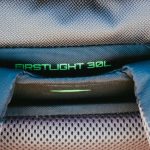Did you know that ripstop nylon can withstand tears up to five times better than standard nylon? When you’re selecting a fabric for your tent floor or rainfly, durability isn’t the only factor to contemplate. You’ll want to balance strength with waterproofing, weight, and cost. Understanding these trade-offs can help you choose the right material that holds up in tough conditions without weighing you down.
Table of Contents
Key Takeaways
- Nylon, especially high-denier and ripstop variants, offers superior durability and puncture resistance for both tent floors and rainflies.
- Polyester provides excellent abrasion resistance and maintains shape under tension, making it ideal for rainflies exposed to UV rays.
- Polyethylene is a cost-effective option for tent floors but generally lacks long-term durability compared to nylon or polyester.
- Waterproof coatings and treatments on nylon or polyester fabrics ensure reliable water resistance and protection during heavy rain.
- Balancing strength-to-weight ratio, ripstop nylon offers rugged durability without excessive weight, enhancing portability and protection in rough terrain.
Key Properties to Consider for Tent Floor Materials
When choosing a tent floor fabric, you need to focus on durability, waterproofing, and resistance to abrasion. Different fabric types offer unique benefits, so it’s crucial to understand their characteristics before making a choice.
Common materials include polyester, nylon, and polyethylene, each varying in strength and waterproof capabilities. Durability tests help you evaluate how well a fabric withstands wear and tear, guaranteeing it holds up under rough terrain and frequent use.
You’ll want a material that resists punctures and tears while preventing water from seeping in. Also, consider how the fabric manages weight and packability without compromising protection.
Comparing Strength and Tear Resistance of Popular Fabrics
Understanding how different fabrics handle stress is key to selecting the right tent floor material.
When comparing strength and tear resistance, nylon durability stands out. Nylon’s tightly woven fibers resist punctures and tears, making it ideal for rugged terrain.
Polyester performance also impresses, offering solid resistance to stretching and abrasion. While polyester may not match nylon’s ultimate strength, it excels in retaining shape under tension and resists UV degradation better.
If you want a balance, nylon is your go-to for toughness, but polyester offers durability with consistent performance over time.
Knowing these differences helps you choose a fabric that withstands the wear and tear of camping, ensuring your tent floor stays intact no matter where you camp.
Water Resistance and Waterproofing Capabilities
Since your tent floor directly contacts the ground, its water resistance and waterproofing capabilities are essential to keeping you dry. You want fabric treated with reliable waterproof coatings that prevent water from seeping through, even during heavy rain.
These coatings form a barrier that repels moisture while maintaining breathability, so condensation doesn’t build up inside your tent. Additionally, effective moisture barriers underneath the fabric add extra protection against dampness from wet ground or puddles.
When choosing tent floor material, prioritize fabrics with proven waterproof coatings and integrated moisture barriers to guarantee you stay comfortable and dry throughout your outdoor adventure. This combination not only keeps water out but also enhances the overall durability of your tent’s base.
Evaluating the Strength-to-Weight Ratio for Portability
Although durability is crucial, you’ll also want to take into account the strength-to-weight ratio when choosing tent floor fabric.
Lightweight materials make your gear easier to carry on long hikes, but they must still hold up under stress. Durability testing is essential to find fabrics that balance toughness with minimal weight.
For example, some high-denier nylon fabrics offer excellent abrasion resistance without adding bulk. You should look for materials proven to withstand punctures and tears while keeping your pack light.
This balance guarantees your tent floor can endure rough terrain without slowing you down. By prioritizing strength-to-weight ratio, you get a reliable, portable shelter that won’t weigh you down during your outdoor adventures.
Cost Implications of Different Tent Fabrics
When choosing tent floor fabric, you’ll quickly notice that cost varies widely depending on the material’s quality and durability.
Budget considerations often lead you to opt for affordable fabrics like polyethylene, but these may wear out faster, reducing fabric longevity.
On the other hand, investing in higher-end materials such as ripstop nylon or polyester treated with waterproof coatings can increase upfront costs but offer better resistance to tears and abrasion, extending the life of your tent floor.
Balancing initial expense with long-term durability means you’ll save money over time by avoiding frequent replacements.
Ultimately, understanding how each fabric’s cost aligns with its expected lifespan helps you make an informed choice that fits your budget without sacrificing performance.
Practical Tips for Choosing and Maintaining Tent Floors and Rainflies
To get the most out of your tent floors and rainflies, you’ll want to focus on both selection and upkeep.
Choose fabrics known for durability and water resistance, such as ripstop nylon or polyester with a polyurethane coating. These materials balance strength with weight, making them ideal for various conditions.
Opt for durable, water-resistant fabrics like ripstop nylon or coated polyester for lightweight, reliable tent protection.
When it comes to tent maintenance, always clean your gear after each trip using mild soap and water, avoiding harsh chemicals that can degrade fabric.
Store your tent floors and rainflies dry and away from direct sunlight to prevent UV damage. Regularly inspect seams and coatings, repairing small tears before they worsen.
Proper fabric care not only extends your tent’s lifespan but also guarantees reliable protection in the wild, letting you enjoy your adventures worry-free.
Frequently Asked Questions
How Do Tent Floor Fabrics Affect Tent Ventilation and Breathability?
Oh sure, tent floors are basically your personal sauna generator! But seriously, your ventilation strategies hinge on breathability factors; less breathable fabrics trap moisture, so you’ll want materials that balance durability with airflow to keep things comfy inside.
Can Tent Fabric Types Impact Environmental Sustainability?
You can impact environmental sustainability by choosing tent fabrics made from sustainable materials. When you prioritize eco friendly practices, you help reduce waste and pollution, making your outdoor adventures kinder to the planet.
What Colors of Tent Fabrics Best Resist UV Damage?
You know, UV rays can degrade fabrics up to 50% faster in bright colors. Choosing darker fabric colors boosts UV resistance, helping your tent last longer by absorbing and blocking more harmful sunlight effectively.
Are There Specific Fabrics Better Suited for Extreme Cold Weather?
When you camp in extreme cold weather, you’ll want fabrics with excellent insulation, like nylon or polyester with a polyurethane coating. These materials trap heat better, keeping you warmer and more comfortable through harsh conditions.
How Do Different Fabrics Respond to Mold and Mildew Buildup?
You’ll notice that synthetic fabrics offer better mold resistance and mildew prevention than natural fibers. They dry faster and don’t absorb moisture, reducing mold buildup. Treating fabrics with repellents also helps keep mildew at bay.
- Tetron Fabric for Marine Applications: Durability and Use Cases - June 18, 2025
- Tetron Fabric for Outdoor Furniture: Weather Resistance and Care - June 18, 2025
- Tetron Fabric for Wall Coverings: Style and Application Tips - June 18, 2025






